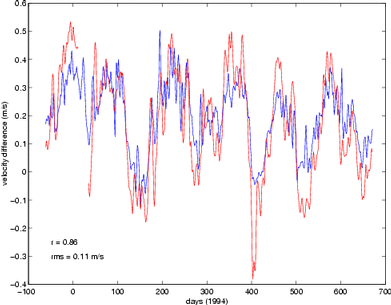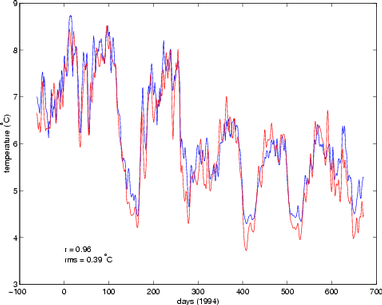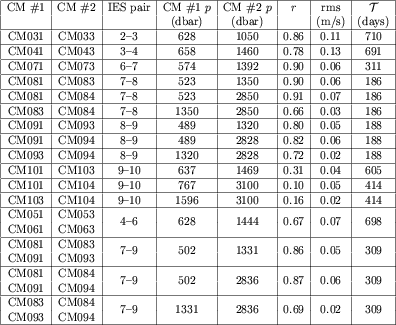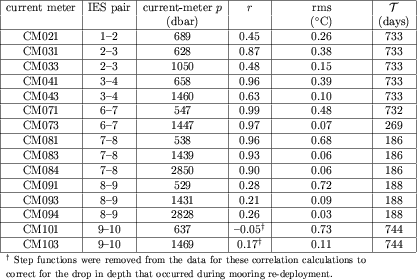Velocities continued |
Velocities and temperatures calculated from the GEM's compare well
with independently measured velocities and temperatures from current
meters. Current records from two working current meters at separate
levels on the same mooring were differenced and compared to an
IES-measured, GEM-calculated velocity difference. At each measurement
time, we differenced the GEM relative-velocity profiles at the
pressures indicated by the two current-meter pressure records, to
allow for the vertical motions of the current meters. To compare
temperatures, the temperature record from a single current meter was
compared to the GEM-calculated value at the pressure level of the
current meter, as indicated by its pressure record. Below are two
representative comparisons and two tables presenting all
these comparisons.
|

|

|
|
Current-meter velocity differences (red) and GEM-calculated
geostrophic velocity differences (blue) between nominal depths of 628
m and 1050 m. The current-meter velocity differences were measured
half way between IES2 and IES3. The GEM velocity differences
represent 20-km spatial averages of the velocity differences between
these two IES. r and rms are the correlation coefficient and rms
difference between the two time series.
|
Comparison at a nominal depth of 658 m between current-meter measured
T (red) half way between IES3 and IES4 and the
GEM-calculated T at IES3 and IES4 (blue). IES3 and IES4 are 21 km
apart. The GEM T time series are sampled between the depth of the
current meter for each particular time sample. r and rms are the
correlation coefficient and rms difference between the two time
series.
|

|

|
|
Comparisons between
current-meter (CM) measured velocity differences and
GEM-calculated geostrophic velocity differences. The pressure
levels given for the current meters are the average depth of
the respective current meter for the time periods (T)
when both current meters and both IES's were working. r and
rms are the correlation coefficient and rms difference between
the two time series. Linear interpolations of depths and
currents were used for the above comparisons that involve four
current meters.
|
Comparisons between
current-meter measured temperatures and GEM-calculated
temperatures. The pressure level given for the current meter
is the average depth of the respective current meter for the
time periods (T) when both IES's and the current meter
were working. r and rms are the correlation coefficient and
rms difference between the two time series.
|
Much of each difference between these time series is attributable to
the fact that a current meter takes a point measurement while a GEM
value represents a horizontal average between pairs of IES's (in the
case of velocity) or an average of the two IES sites (in the case of
temperature). As the spacing between IES's increases, the comparisons
should degrade. Much of the failure of the GEM calculated variables
to match well with their current-meter counterparts at mooring 10 is
probably due to the difference between an average over 360 km and a
point measurement. Most of the comparisons have high correlation
coefficients and low rms differences. Thus, the current-meter data
provide independent verification of the accuracy of the GEM method.
|



